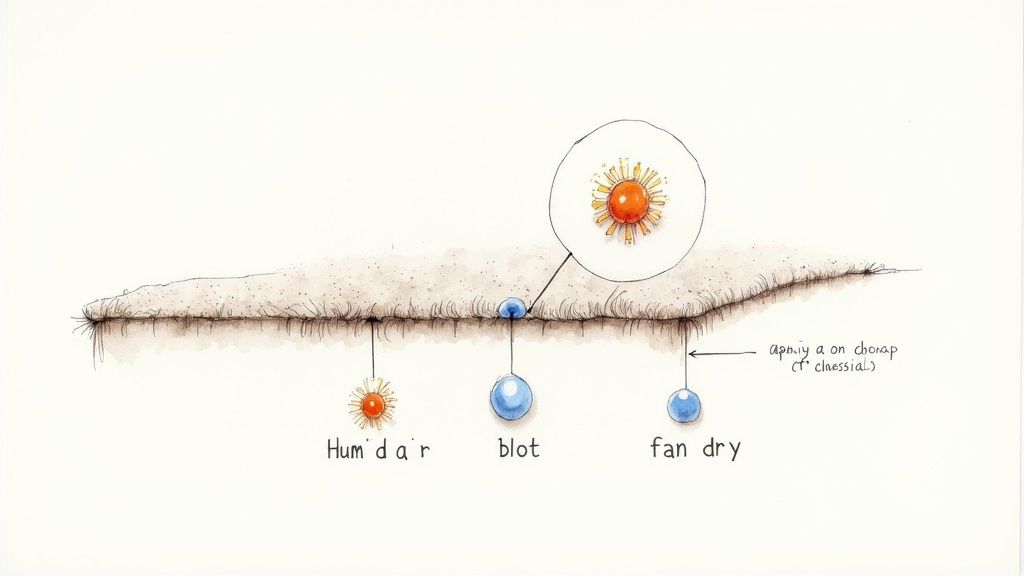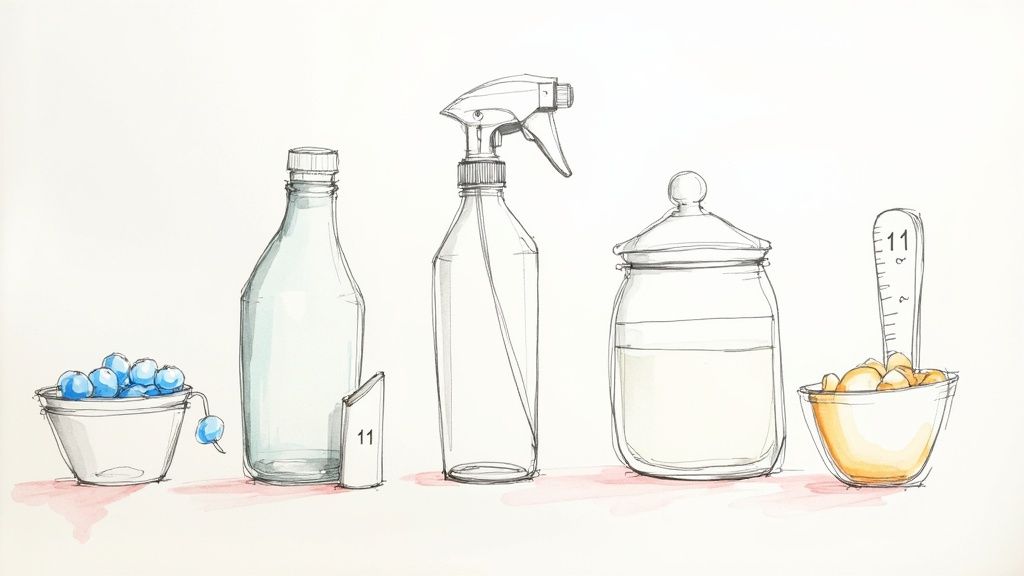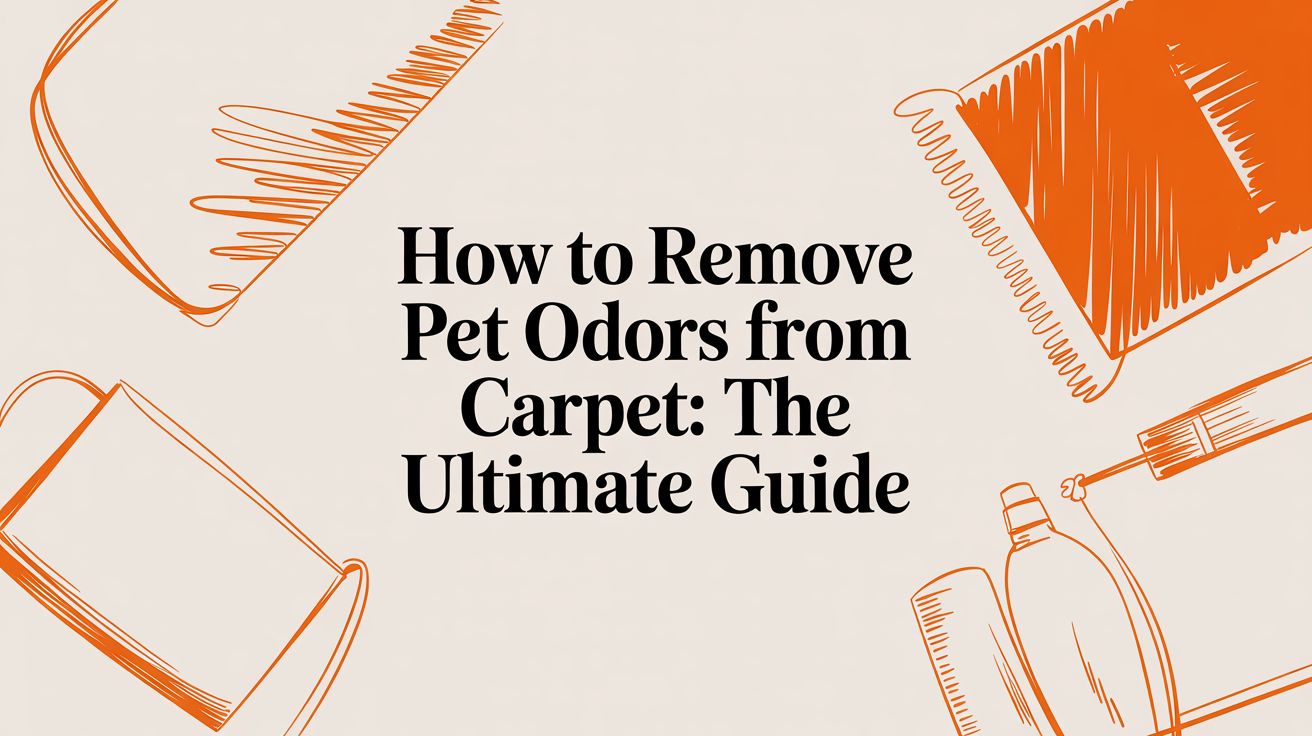To get pet odors out of your carpet for good, you have to hit the source of the problem. That means blotting up fresh accidents the moment they happen and then going after the spot with a good enzyme cleaner that breaks down the nasty uric acid crystals causing the smell.
If you're dealing with older, more stubborn smells that just won't quit, you'll need to bring in the big guns. This could be a combination of DIY tricks, like using baking soda and a citrus-based cleaner, or calling in a professional for a deep clean to finally knock out the odor.
Understanding Why Pet Odors Are So Stubborn
Before you can really win the war against those lingering pet smells, you have to understand the enemy. That funky, recurring odor isn't just a bit of dirt; it's a full-blown chemical reaction happening deep down in your carpet fibers. When a pet has an accident, they're leaving behind a lot more than just a wet spot.
The real villain here is uric acid, a sneaky component of urine that doesn't dissolve in plain water. You might clean up the visible stain and think you're done, but microscopic uric acid crystals are left behind, clinging to the carpet fibers and soaking into the padding underneath.
The Science Behind Lingering Smells
This is exactly why pet odors seem to magically reappear on humid days or right after you've tried steam cleaning. Any moisture in the air basically "wakes up" those dormant uric acid crystals, and suddenly, that awful smell is back. Trying to cover it up with air fresheners or standard carpet shampoos is a losing battle because they don't actually break down the crystals. To truly get rid of the odor, you need something that neutralizes the uric acid on a molecular level.
This is such a common headache for homeowners that it's created a huge market. The global pet stain and odor control industry was valued at around USD 9,828.23 million, which just goes to show how many of us are desperately looking for a real solution.
The main takeaway is this: you can't just cover up the smell. You have to destroy the odor-causing compounds at their source. That's the only way to get a truly fresh-smelling home.
Your Immediate Action Plan
Responding quickly when an accident happens is the single most important thing you can do. Seriously, acting fast stops the urine from seeping deep into the carpet pad and subfloor, where it becomes a nightmare to remove without professional help. A quick response prevents those uric acid crystals from bonding tightly with the carpet fibers in the first place. For a more detailed breakdown, take a look at our guide on how to eliminate pet urine smell from carpet.
The infographic below walks you through the essential first steps to take the second you find a fresh stain.

This simple process—blot, rinse, and treat—is your best defense. It dramatically increases your chances of getting the stain and the smell out completely before they have a chance to set in for good.
Here’s a quick-reference table for what to do the moment disaster strikes. Acting immediately is key.
Immediate Action Plan for Fresh Pet Stains
| Action | Tool or Material | Why It Is Important |
|---|---|---|
| Blot Immediately | Clean, dry microfiber towels or paper towels | Absorbs as much liquid as possible before it soaks into the carpet pad. Do not rub! |
| Rinse Gently | Cold water in a spray bottle | Dilutes the remaining urine without spreading the stain. Avoids "setting" the stain with heat. |
| Blot Again | Fresh, dry towels | Removes the diluted urine and excess water. Standing on the towel adds pressure for better absorption. |
| Apply Cleaner | Enzyme-based or citrus cleaner | Breaks down the uric acid crystals at a molecular level, truly eliminating the source of the odor. |
Following these steps right away can make the difference between a minor cleanup and a permanent odor problem. Keep these supplies handy so you're always ready.
Powerful DIY Solutions That Actually Work

You don't need a cabinet overflowing with expensive, store-bought chemicals to win the war against pet odors. Honestly, some of the most effective solutions are probably sitting in your pantry right now.
The real secret isn't just knowing what to grab, but understanding how to use it for maximum impact. Forget that generic advice that just leaves you with a soupy, useless paste on your floor. Let’s get into the methods that actually deliver results for everything from a fresh puddle to that mystery smell you just can’t seem to place.
The Baking Soda Deep-Absorption Method
Baking soda is a true champion at absorbing odors, but just sprinkling a little on top won't cut it for smells that have settled deep into your carpet. For this to really work, you have to get the baking soda down into the carpet fibers where the odor-causing bacteria are having a party.
First, and this is critical, make sure the area is completely dry. If you're tackling a recent accident, blot it up thoroughly with a microfiber towel and let it air-dry first. A damp carpet will just turn your baking soda into a clumpy, ineffective mess.
Once it's dry, don't be shy. Pour on a thick layer of baking soda over the entire spot. You want enough to create a substantial white blanket. Then, take a soft-bristled brush and gently work the powder deep into the carpet pile.
Now comes the hard part: waiting. Let it sit for at least 12-24 hours. This long dwell time is absolutely crucial for the baking soda to do its job absorbing the last bits of moisture and neutralizing those pesky uric acid crystals.
After you've waited, vacuum the area slowly and thoroughly. Go over the spot from multiple directions to make sure you pull up all the powder. You should notice a huge difference in the smell almost immediately.
DIY Citrus and Vinegar Neutralizer
This homemade solution is a fantastic one-two punch. The acidic power of vinegar breaks down the urine salts, while the natural citrus oils act as a deodorizer and cleaner. It’s a great alternative to harsh chemicals and leaves behind a much fresher scent. Plus, it’s ridiculously easy to make.
Here's what you'll need:
- One part white vinegar: This is the workhorse that neutralizes the ammonia in urine.
- One part water: This dilutes the vinegar to make it safe for most types of carpet.
- Citrus Peels: Orange, lemon, or grapefruit peels work great. They contain d-limonene, a natural solvent and degreaser.
To mix it up, just combine the vinegar, water, and a handful of citrus peels in a clean spray bottle. Let the mixture sit for about 24 hours. This gives the citrus oils time to infuse into the liquid, making it much more powerful.
Pro Tip: Always, always spot-test any cleaner—homemade or store-bought—on a hidden area of your carpet first. Try it inside a closet or under the sofa. This makes sure it won't cause any discoloration, which is especially important on natural fibers like wool.
Spray the solution liberally on the stain, but try not to completely soak the carpet and padding underneath. Let it sit for about 15-20 minutes, then blot the area firmly with a clean, dry cloth to pull up the moisture and the dissolved odor molecules.
This DIY method is perfect for refreshing your carpets and handling moderate odors. If you want a more complete rundown of the cleanup process, our guide on the best way to clean up after a pet accident has even more great insights.
Choosing the Right Commercial Carpet Cleaner

While my DIY citrus cleaner is fantastic for a lot of situations, sometimes a stubborn pet problem calls for the heavy-duty power you can only find in a store-bought product.
Walking down the cleaning aisle is dizzying, right? Every bottle promises to be a miracle worker. The trick is to tune out the flashy marketing and learn how to read the labels like a pro. Once you understand what's actually in the bottle, you can make a choice that gets the job done right the first time.
Most of these pet odor removers fall into two main categories, and they work in completely different ways. Knowing which one you need is the secret to success.
Enzymatic vs Oxygenated Cleaners
The two heavy hitters in the world of pet stain removal are enzymatic cleaners and oxygenated cleaners. They are absolutely not interchangeable. Picking the right one depends entirely on the kind of mess you're cleaning up.
- Enzymatic Cleaners: Think of these as biological warfare on pet messes. They’re packed with beneficial bacteria that produce enzymes specifically designed to break down and literally "eat" the organic proteins in urine, feces, and vomit. They are the gold standard for urine odors because they target the uric acid crystals that cause that lingering smell.
- Oxygenated Cleaners: These guys work through a chemical reaction. When they hit the organic material in a stain, they unleash oxygen bubbles that lift the gunk and odor particles right out of the carpet fibers. They're fantastic for getting rid of visible stains from things like mud, blood, or even spilled food.
For pet urine, an enzymatic cleaner is almost always your best bet. An oxygenated cleaner might get rid of the yellow stain, but it often leaves behind the invisible, smell-causing uric acid crystals deep in your carpet. That means the smell will be back to haunt you on the first humid day.
If you're curious about the science, we break it down even further in our article explaining what an enzymatic cleaner is.
Decoding the Product Label
When you're trying to figure out how to get rid of pet odors for good, the ingredient list is your best friend. Ignore claims like "odor destroying" and look for the actual science behind the promise.
If you need an enzymatic cleaner, look for terms like "enzymes," "live bacterial cultures," or even specific enzyme types like protease (for proteins) and amylase (for starches). A reputable brand will clearly label its product as an enzymatic or bio-enzymatic formula.
For an oxygenated cleaner, you're looking for ingredients like hydrogen peroxide or sodium percarbonate. These are the compounds that create that fizzing, oxidizing reaction.
The global market for pet odor products is huge and getting bigger, projected to hit USD 16.16 billion by 2030. That growth means more products are flooding the shelves, making it even more important for you to know what you’re actually buying.
At the end of the day, picking the right commercial cleaner is about matching the product's function to your specific problem. For that stubborn, lingering urine smell, always grab a high-quality enzymatic cleaner. For other types of organic stains, an oxygenated cleaner can be a powerful tool in your cleaning kit.
Sometimes, no matter how much you spray and blot, that funky pet smell just won't quit. You clean the same spot over and over, but the odor comes creeping back. When the smell seems to have taken over a whole room, you're past the point of surface cleaning.
The problem is that the source of the smell—usually urine—has soaked deep into the carpet fibers, and maybe even into the padding underneath. This is exactly when it's time to stop messing around with spray bottles and bring in the big guns: a carpet cleaning machine.
A simple spray just can't get deep enough. A carpet cleaner, what we in the business often call a hot water extractor, is built to get way down into the carpet pile. It shoots a cleaning solution deep into the fibers and then sucks all that dirty water right back out, pulling up the nasty uric acid crystals that cause that lingering smell.
Should You Rent a Carpet Cleaner?
For most folks dealing with serious pet odors, renting a carpet cleaning machine is the way to go. It’s practical and a whole lot cheaper than calling a pro right away. You can find them at most grocery stores or places like Home Depot.
Now, I'll be honest—they aren't as powerful as the truck-mounted monsters we use. But a good rental machine can still do a fantastic job if you know how to use it right.
Think about renting a machine if:
- The pet smell is all over a large area or has taken over an entire room.
- You've got a bunch of old stains that are creating a general "doggie" or "kitty" aroma.
- You've already tried spot treatments, but the smell just keeps coming back.
It's no surprise these machines are becoming more popular. The global market for carpet extraction cleaners is on the rise, set to jump from US$1.7 billion to US$2.5 billion. That's because people are realizing how well this deep-cleaning method works for tough jobs like pet messes. You can dig into more details about this trend and the carpet cleaner market to see how technology is helping homeowners fight back.
How to Get Pro Results from a Rental Machine
Just grabbing a machine and pushing it around won't cut it. You can easily make things worse. I've seen it a hundred times: people either soak their carpet or leave behind a sticky, soapy mess. Overwetting is a huge risk. If your carpet takes forever to dry, you’ve just traded a pet odor problem for a mildew problem. Not a good trade.
Here are a few tips from a pro to get the best results possible:
- Vacuum Like You Mean It: Before you even think about adding water, vacuum the area thoroughly. Get up all that loose fur, dander, and dirt. If you don't, you're just making mud.
- Get the Right Cleaner: Don’t just use any old soap. Look for a low-foam, pet-safe cleaning solution made specifically for carpet extractors. An enzymatic cleaner is your best friend here—it's designed to literally eat the proteins in urine.
- Pre-Treat the Hot Spots: Find the worst areas and spray your cleaning solution directly on them. Let it sit for about 10-15 minutes before you start the full cleaning. This gives those little enzymes a head start on breaking down the mess.
The biggest mistake I see people make is using way too much cleaning solution. More soap doesn't mean a cleaner carpet. It just leaves behind a sticky residue that becomes a dirt magnet and makes your carpet look dull. Follow the instructions on the bottle—they're there for a reason.
One last thing. After you go over a section with the cleaning solution, do another pass without spraying any more water. This is called a "dry" pass, and it's critical. It pulls out as much moisture as possible, which drastically cuts down your drying time and stops mildew from even thinking about growing.
Of course, knowing how to get pet smells out of the carpet is a great skill to have in your back pocket. But let's be honest, the best strategy is always playing a good defense.
Preventing those accidents and odors from happening in the first place saves you a ton of time, stress, and frankly, protects the investment you've made in your home's flooring.
A proactive approach is about more than just house training. It’s really about creating an environment that minimizes the risk of accidents and makes cleanup a breeze when they (inevitably) do happen. This means looking at everything from your pet's daily routine to the very fibers under your feet.
Building an Odor-Resistant Environment
Creating a home that stays fresh really starts with understanding your pet's needs and habits. A few simple tweaks can make a massive difference in stopping those recurring issues that lead to stubborn carpet smells.
Here are a few proactive steps I've seen work time and time again:
- Frequent Potty Breaks: This is a big one, especially for puppies and senior dogs. A consistent schedule is your best friend. It prevents accidents by giving them plenty of chances to do their business outside.
- Regular Grooming: A clean pet means cleaner carpets. It's that simple. Regular baths and brushing cut down on the dander, oils, and general funk they track inside, all of which contribute to that general "pet smell."
- Address Behavioral Issues: Sometimes, accidents aren't just accidents. They can be a sign of stress, anxiety, or even a medical problem. If you notice a sudden change in behavior, a quick trip to the vet is a smart move to rule out any underlying health issues.
A huge part of preventing odors from being tracked indoors is managing pet waste outside. Exploring modern dog waste disposal systems can help keep your yard clean, which means less mess gets tracked back into the house on paws and shoes.
Remember, an accident-prone pet might be trying to tell you something. Getting to the root of the cause—whether it's medical or behavioral—is the single most effective way to protect your carpets for the long haul.
Your choice of materials can also be a total game-changer. If you happen to be planning a renovation, look into carpet fibers with low porosity, like polyester or triexta. These materials are way less absorbent than natural fibers like wool, making them much more resistant to deep-set stains and odors.
And for an extra layer of defense? A good carpet protector spray can add a valuable barrier, giving you more time to clean up messes before they have a chance to soak in.
Common Questions About Pet Odor Removal

Even after you’ve done everything right, some situations can still leave you scratching your head. Trust me, you're not the first person to wonder about the little details that make a huge difference in the war against pet odors.
This section is all about tackling the most common questions we hear from homeowners just like you. I want to give you clear, direct answers so you can troubleshoot those tricky spots like a pro.
Can I Use a Steam Cleaner on Pet Urine Odor?
This is a huge one, and the answer is a hard no. It's probably the most common—and most damaging—mistake people make when trying to get pet smells out of their carpet. Never, ever use a traditional steam cleaner on a urine stain.
Why? The intense heat from a steam cleaner will literally cook the proteins and uric acid crystals from the urine right into your carpet fibers. It creates a chemical reaction that permanently bonds the stain and the odor to your carpet. Once that happens, the smell is almost impossible to get out, even for professionals. It’s a game-over situation.
Instead of high heat, you need to use cool or lukewarm water. A carpet extractor, which flushes the area with water and immediately sucks it back up, is a much safer bet.
How Can I Find Old, Hidden Pet Stains?
Sometimes you can smell a problem long before you can see it. When you’re dealing with a mystery odor and just can't pinpoint the source, a UV blacklight is your absolute best friend. These things are like magic, showing you what the naked eye completely misses.
Here’s how to use one effectively:
- Wait until it's dark and kill all the lights in the room. The darker, the better.
- Slowly sweep the blacklight over the carpet, holding it just a foot or two above the fibers.
- Dried urine contains salts and proteins that glow under UV light, usually in a funky yellowish-green color.
When you find a spot, mark it with a small piece of painter's tape or a sticky note. This takes all the guesswork out of locating those old, invisible stains so you can treat the problem directly at the source.
You can't defeat an enemy you can't find. A UV light is the only surefire way to uncover every single problem area. It ensures you don't miss a spot and then wonder why that smell is still hanging around.
When Should I Give Up and Call a Professional?
Knowing when to throw in the towel and call for backup is key. DIY methods and rental machines can do a lot, but some jobs just require commercial-grade equipment and expertise.
It’s time to call a professional if:
- The odor is still there after two or three of your own thorough cleaning attempts.
- The affected area is massive or covers multiple rooms.
- You think the urine has soaked through the carpet and into the padding or even the subfloor. This is a big one.
Once moisture gets into the subfloor, no amount of surface cleaning is going to fix it. Professionals have specialized tools and much stronger, citrus-based solutions that can tackle deep contamination without oversaturating your floors. Calling in an expert can save you a ton of time, frustration, and ultimately, the cost of replacing your entire carpet.
Ready to skip the guesswork and get your carpets professionally deep-cleaned? Citrus Carpet Cleaning Buford uses a low-moisture, citrus-based system that eliminates pet odors at the source without leaving behind sticky residue. Call or text us today for your free "EXACT-imate"! https://citruscarpetcleaningatlanta.com

